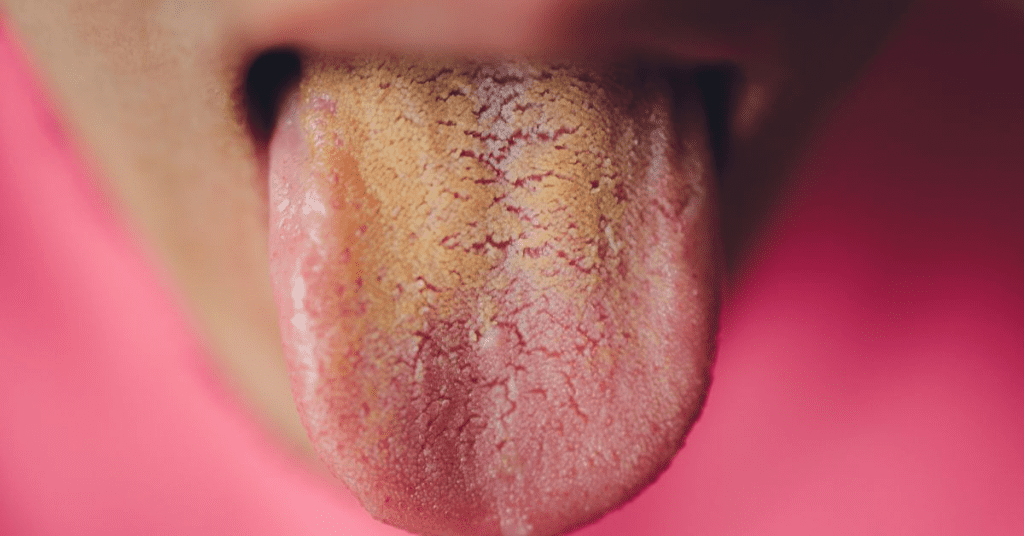Your tongue might not be the first thing you consider when assessing your health, but this remarkable muscle offers crucial insights into your well-being. As a key player in taste, speech, and swallowing, changes in your tongue’s appearance, texture, and color can signal underlying health issues. Let’s dive into what different tongue characteristics might reveal about your health and when you should seek medical advice.
Understanding Tongue Health: What a Healthy Tongue Looks Like

A healthy tongue should be pink, moist, and covered in small nodules called papillae, which contain taste buds. These tiny structures help you experience a range of flavors. Any significant changes—such as shifts in color, texture, or moisture—might indicate an underlying health issue, from minor nutritional deficiencies to systemic diseases. Recognizing these early signs can help you address potential health concerns before they progress.
1. White Coating or Patches on the Tongue
A white coating or patches on your tongue are common signs that something might be amiss with your oral or systemic health.
- Oral Thrush: A white coating that resembles cottage cheese could indicate oral thrush, a fungal infection caused by an overgrowth of Candida yeast. This condition is especially common in people with weakened immune systems, diabetes, or those who wear dentures. While oral thrush can be treated with antifungal medication, it’s best to address it promptly to avoid discomfort.
- Leukoplakia: If you notice white patches that don’t scrape off, you may be dealing with leukoplakia. This condition, often linked to tobacco or alcohol use, can sometimes lead to oral cancer. It’s important to have persistent patches evaluated by a healthcare provider.
2. Red Tongue: Causes and Concerns
A bright red or swollen tongue may indicate specific nutritional deficiencies or other underlying health issues.
- Nutritional Deficiencies: A swollen, red tongue is often a sign of vitamin B12 or folic acid deficiencies, which can cause a condition known as glossitis. This condition leads to a smooth, swollen tongue and can cause pain or burning. Addressing these deficiencies with dietary changes or supplements can restore normal tongue health.
- Geographic Tongue: This harmless condition, also known as benign migratory glossitis, causes map-like patches on the tongue due to loss of papillae. These smooth, red areas can shift in shape and location over time. Although the exact cause is unclear, genetic factors and certain inflammatory conditions, like psoriasis, may play a role. Typically, geographic tongue doesn’t require treatment unless discomfort arises.
- Kawasaki Disease and Scarlet Fever: Pediatric conditions like Kawasaki disease and scarlet fever can cause a red, swollen tongue, sometimes called a “strawberry tongue.” While Kawasaki disease is an inflammatory condition primarily affecting young children, scarlet fever is caused by a streptococcal bacterial infection. Both conditions require prompt medical treatment to prevent complications.
3. Purple or Blue Tongue: A Sign of Circulation Issues
If your tongue appears purple or blue, it might indicate a problem with blood circulation or oxygen levels.
- Circulation Issues: A blue or purple tongue may suggest that your body isn’t receiving enough oxygen due to cardiovascular or respiratory problems. This could signal heart or lung issues that need immediate attention. Poor circulation affects oxygen delivery to tissues, so it’s crucial to consult a healthcare professional if you notice this change.
4. Yellow Tongue: What Causes This Discoloration?

A yellow tongue is usually linked to benign causes, but persistent discoloration should not be ignored.
- Poor Oral Hygiene: Accumulated bacteria, food particles, and dead skin cells can cause a yellow coating on the tongue, especially if oral hygiene is lacking.
- Dry Mouth and Diet: Dry mouth or certain foods and drinks, like coffee or tea, can lead to a yellowish tint. Tobacco use and mouth breathing can also contribute to a yellow appearance.
- Jaundice: In rare cases, a yellow tongue can indicate jaundice, a condition where the liver fails to process bile correctly. If you notice yellowing of the skin, eyes, and tongue, consult a healthcare provider promptly.
5. Cracked or Fissured Tongue: Possible Causes
A cracked or fissured tongue can be harmless, but it may also signal other health issues. Known as fissured tongue, this condition often doesn’t cause pain, but cracks can trap food particles and bacteria, leading to discomfort.
- Normal Variation: For many, a fissured tongue is simply a normal variation and is often inherited. While usually harmless, it can become more pronounced with age.
- Geographic Tongue: People with geographic tongue sometimes develop fissures as part of the condition, which can change in location and severity over time.
- Nutritional Deficiencies and Dehydration: A lack of certain nutrients, such as vitamin B12 or iron, or dehydration can lead to cracking. Ensuring you stay hydrated and address any deficiencies can improve tongue appearance.
Nutritional Deficiencies and Overall Health Reflected in the Tongue
The tongue can reveal critical information about your nutritional status. For example, vitamin B12 or iron deficiencies can lead to a smooth, swollen, and red tongue, accompanied by a burning sensation. These deficiencies can affect your energy levels, cognitive function, and immune system, making it vital to address them through diet or supplements.

Oral Hygiene’s Role in Maintaining Tongue Health
Good oral hygiene goes beyond brushing and flossing. Regularly cleaning your tongue helps prevent the buildup of bacteria, food debris, and dead cells that cause a white coating or bad breath (halitosis). Incorporating tongue scraping or brushing your tongue daily can prevent oral health issues and contribute to overall wellness. By practicing good oral hygiene, you lower your risk of gum disease, tooth decay, and systemic health problems related to oral health.
When to Seek Medical Advice for Tongue Changes
While many tongue changes are harmless, certain symptoms may indicate a more severe condition. Persistent sores, lumps, or patches that don’t resolve, as well as unexplained pain or difficulty swallowing, warrant professional evaluation. Such symptoms could indicate oral cancer or other systemic health issues. Early intervention is critical, as it can be life-saving in severe cases.
Conclusion: Your Tongue as a Window to Health
The tongue is an often-overlooked indicator of overall health, capable of revealing vital clues about nutrition, circulation, and potential illnesses. By monitoring changes in color, texture, and appearance, you can detect signs that may signal underlying health issues. Practicing good oral hygiene and seeking medical advice when necessary can help you maintain not only a healthy mouth but also a healthy body.


